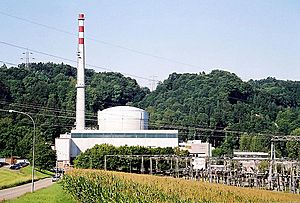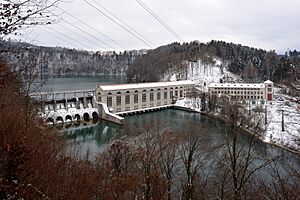Mühleberg facts for kids
{{Infobox Swiss town | subject_name = Mühleberg | image_photo = Guemmenen Dorfansicht 01 09.jpg | municipality_type = municipality | imagepath_flag = CHE Mühleberg Flag.svg | imagepath_coa = Coat of arms Mühleberg.svg | canton = Bern | iso-code-region = CH-BE | district = Bern-Mittelland |coordinates = 46°57′N 7°16′E / 46.950°N 7.267°E | postal_code = 3203 (Mühleberg)
3205 (Gümmenen) | municipality_code = 0668 | area = 26.3 | elevation = 557|elevation_description= | population = 2997 | populationof=December 2020 | website = www.muehleberg.ch | mayor = Kurt Herren|mayor_asof=|mayor_party= | mayor_title = |list_of_mayors = | places = Allenlüften, Aumatt, Brand, Buch bei Mühleberg, Buttenried, Dällenbach, Eggenberg, Fluh, Fuchsenried, Gäu, Grossmühleberg, Gümmenau, Gümmenen, Haselholz, Heggidorn, Juchlishaus, Kirchmoos, Ledi, Mädersforst, Marfeldingen, Mauss, Michelsforst, Mühleberg, Niederruntigen, Oberei bei Mühleberg, Rosshäusern, Rüplisried, Rüplisried‑Mauss, Salzweid, Schnurrenmühle, Spengelried, Strassacker, Trüllern, Zihlacker | demonym = | neighboring_municipalities= Bern, Ferenbalm, Frauenkappelen, Golaten, Laupen, Neuenegg, Radelfingen, Wileroltigen, Wohlen bei Bern | twintowns = Schwanfeld (Germany) |} Mühleberg is a small town, also called a municipality, in the Bern-Mittelland area of the canton of Bern in Switzerland. It's a cool place with a mix of old history and modern power plants!
Contents
History of Mühleberg
Mühleberg was first mentioned in old writings between 1011 and 1016. Back then, it was called Mulinberg.
Long, long ago, during the Hallstatt era (which was around 800-450 BC), people lived here. We know this because several ancient grave mounds have been found. The most important one is called Unghürhubel, which means "monster hill." In 1869, an amazing discovery was made there: a fancy necklace made of heavy gold and a gold bracelet! Other valuable metal items were probably lost during the digging.
The church and village of Mühleberg were owned by different families over time. In 1599, the town of Bern bought it. Mühleberg then became part of the bailiwick (an area managed by a special officer) of Laupen.
St. Martin's Church was first mentioned in 1224. It was originally a simple Romanesque church from the 11th century. The church tower was built in the 12th century. It was made bigger in 1523–24 and became the main church for a large area. After the Protestant Reformation, the church also served the nearby town of Frauenkappelen.
A hydroelectric power plant was built in Mühleberg between 1917 and 1921. This plant uses water to create electricity and also formed Lake Wohlen. Later, the Mühleberg Nuclear Power Plant was built from 1967 to 1971. Both of these plants help provide power to the city of Bern.
After the Chernobyl disaster in 1986, many people became worried about nuclear power. In 1992, people in Bern voted on whether the nuclear power plant should have an unlimited license to operate. A small majority (51%) voted against it. However, in 2003, a different vote asked if the plant should be shut down by 2005 and replaced with other types of power. This time, 68% of people voted to keep the plant open. A similar vote in 2000 also showed that most people wanted the plant to stay. Today, these two power plants are the biggest employers in Mühleberg.
Gümmenen: A Village with a Castle
Gümmenen is another part of Mühleberg. It used to have a medieval castle and village right by the Saane river. It was first mentioned in 1252 as Guminun.
Gümmenen Castle was built to protect a bridge over the river. Nothing is left of the castle today. In 1259, Peter of Savoy made Gümmenen an imperial fief, which meant it was directly under the Holy Roman Emperor. Later, in 1282–83, King Rudolph I of Germany gave it to a knight. The castle and village were attacked and destroyed in 1333 during a war between Bern and Fribourg.
After the war, Gümmenen went back and forth between Fribourg and Bern. In 1467, the border was set, and Gümmenen officially became part of Bern. Around 1450, the first wooden bridge was built here. The current wooden bridge was built much later, between 1732 and 1739. Gümmenen became an important border crossing with taverns, a forge, and a customs house. It remained a customs station until 1853, when Switzerland stopped collecting internal tolls.
Geography
Mühleberg covers an area of about 26.3 square kilometers (10.2 square miles). A big part of this land, about 53.4%, is used for farming. Forests cover about 32.9% of the area. The rest is made up of buildings, roads, rivers, and lakes.
Mühleberg is located in a special area shaped like a triangle, surrounded by the Saane/Sarine River, the Aare River, and Lake Wohlen. The municipality is made up of many small villages, called hamlets, and individual farmhouses.
Coat of arms
The blazon (description) of Mühleberg's coat of arms is: a black shield with a golden mill wheel on three green hills. This design likely represents the "mill" (Mühle) and "hill" (Berg) in the town's name.
Population and People
Mühleberg has a population of about 2,648 people (as of 2022). About 6.2% of the people living here are from other countries. Over the past 10 years, the population has changed a little, mostly due to people moving in and out.
Most people in Mühleberg (about 94.7%) speak German as their main language. A smaller number speak French (1.3%) or Albanian (0.8%).
In 2008, the population was split almost evenly between men and women. About 33.7% of the people living in Mühleberg in 2000 were born there. Many others were born in the same canton (42.4%) or elsewhere in Switzerland (14.0%). About 6.8% were born outside of Switzerland.
Young people (ages 0–19) make up about 21.6% of the population. Adults (ages 20–64) are the largest group at 66.3%, and seniors (over 64) make up 12.1%.
The population of Mühleberg has changed over the years, as you can see in this chart:

Important Heritage Sites
Some places in Mühleberg are very important to Switzerland's history and culture. The Railroad-Viaduct (a bridge for trains) over the Saane river is a heritage site of national significance. This means it's a really important historical landmark! The entire Mühleberg power plant area is also considered a heritage site.
Economy and Jobs
In 2010, Mühleberg had a low unemployment rate of 1.5%. This means most people who wanted jobs had them.
The town has different types of jobs:
- Primary sector: This includes jobs like farming. In 2008, about 216 people worked in this area.
- Secondary sector: This includes jobs in factories and construction. About 587 people worked here.
- Tertiary sector: This includes jobs in services, like shops, hotels, and offices. About 373 people worked in this sector.
The two power plants in Mühleberg are the biggest employers in the municipality.
Power Plants
Mühleberg is well-known for its nuclear power plant, called Kernkraftwerk Mühleberg. There's also a hydroelectric power station that started working in 1921. This plant uses the power of water to create electricity and helped create Lake Wohlen.
Religion
Based on a 2000 survey, most people in Mühleberg (about 78.2%) belong to the Swiss Reformed Church (a type of Protestant church). About 8.9% are Roman Catholic. There are also smaller groups of people who follow other Christian churches, Islam, Buddhism, and Hinduism. About 5.4% of the population said they didn't belong to any church.
Education
In Mühleberg, many adults have completed higher education. About 44.5% have finished upper secondary education (like high school), and 14.5% have gone on to university or a special college called a Fachhochschule.
The school system in the Canton of Bern works like this:
- One year of optional Kindergarten.
- Six years of Primary school.
- Three years of mandatory lower Secondary school, where students are grouped by their abilities.
After lower Secondary, students can choose to continue their schooling or start an apprenticeship (learning a job while working).
Mühleberg also has a library called Bibliothek Mühleberg. In 2008, it had over 8,700 books and other items, and people borrowed over 9,500 items that year!
Transportation
Mühleberg has a train station called Rosshäusern. It's on the train line that connects Bern and Neuchâtel, making it easy for people to travel.
Images for kids
See also
 In Spanish: Mühleberg para niños
In Spanish: Mühleberg para niños




